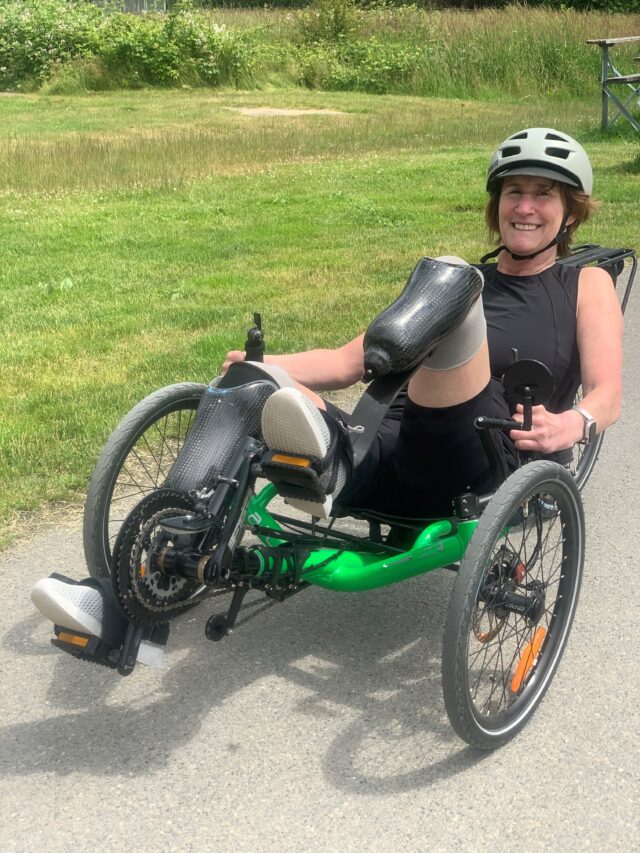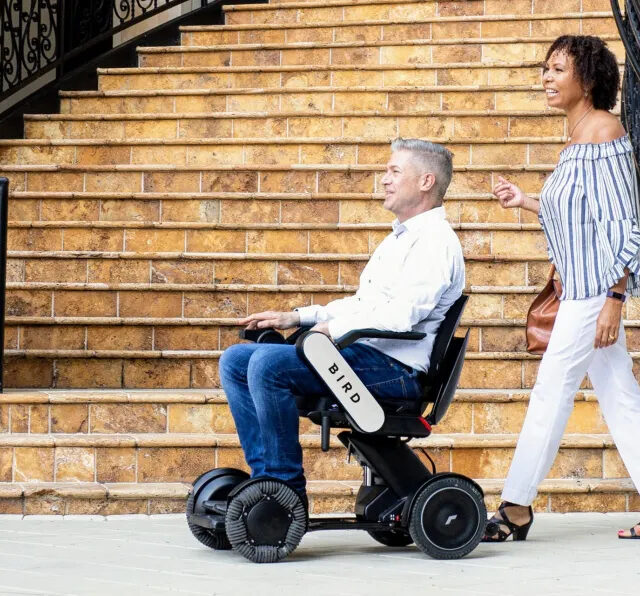In Seattle, Adaptive Bike Share Is for Everyone
by Kiran Herbert, Communications Manager
February 7, 2023
A unique partnership between the city’s transportation department and the Outdoors For All Foundation has allowed more differently-abled riders to experience bicycling.

A young rider smiles while riding an adaptive cycle in Seattle. (Photo credit: Outdoors for All)
With more than 200 bikes, the Outdoors for All Foundation has one of the largest adaptive bike fleets in the country. From handcycles to recumbent trikes to tandem bicycles, there’s a bike to suit almost every rider. Based in Seattle, Washington, Outdoors for All is a nonprofit dedicated to enriching the quality of life for children and adults with disability through outdoor recreation.
Although Outdoors for All has been around since 1979, it wasn’t until the 1990s that bikes became a part of the organization’s programming, and later, in 2013, that it launched a bike rental program. The rental program was originally launched with around 10 bikes and over the last decade has steadily grown through grants and in-kind donations. For years, riders would pay to rent the bicycles, either by the hour or through an unlimited season pass program. In 2019, that all changed when the Seattle Department of Transportation (SDOT) signed on as a partner, supplying the funding necessary so that Outdoors for All could provide the adaptive bike program for free.
The SDOT funding covers maintenance of the bike fleet along with rental costs for any interested user. Open seven days, 10 am to 6 pm, from May through September, and operating out of Magnuson Park on Lake Washington, the program is an accessible way for anyone to rent a non-traditional bike and explore a beautiful area along safe, protected trails. From where Outdoors for All is located, riders can essentially ride for almost 100 miles on dedicated, connected bike lanes.
“When we started with dockless free-floating bike share in 2014, it was highlighted that there were accessibility concerns,” says Becky Edmonds, SDOT’s shared and micromobility program manager. “We also just wanted to provide mobility options for people with different abilities.
SDOT began looking into whether or not it was feasible to add adaptive options into its fleet, ultimately deciding that it wouldn’t be logical in a free-floating environment. The partnership with Outdoors for All just made sense — not only was the organization trusted amongst people with disabilities, but they were already running a successful program. Contracting with an expert in the space also meant that no small detail specific to the population being served was overlooked.
“This is something that already exists in our community and allows us to invest in our community,” says Edmonds, adding that the majority of the program’s funding comes from the fees that bike and scooter share companies pay us for operating permits.

Cheryl Lanzinger rides a Catrike 2. (Photo credit: Outdoors for All)
By providing $75,000 in funding to make the program free during the summer (in the off-season, folks can rent bikes by appointment for a cost), SDOT has reduced one of the major barriers for adaptive riders. Combined with its marketing power as a citywide agency, enrollment in the program has increased substantially in the last few years.
“This partnership has been huge — we’ve gone from 60-70 unique riders in 2017 to 264 in 2022,” says Taylor Moseley, the cycling program manager at Outdoors for All. “The number of riders has essentially quadrupled.”
In addition to a 65% year-over-year growth in the number of unique riders, Outdoors for All has seen an increase in the number of rider experiences (i.e., times an individual visited), and the total time spent in the program. What’s more, in 2022 the average program rating from participants was an impressive 5/5. Moseley attributes the growth to a number of factors, including marketing efforts from SDOT, translated fliers in all of Seattle’s Tier 1 languages (Traditional Chinese, Spanish, Vietnamese, Somali, Amharic, Korean, and Tagalog), and posted fliers in key physical locations, as well as a general rebound from the pandemic.
While Saturday and Sunday were the most popular days for adaptive riders, Tuesday was the third most popular day, highlighting the importance of being open during the week. The program strives to be barrier-free, meaning that participants aren’t required to prove anything — all types of users are welcome, including those that are capable of riding a two-wheeled bike but would rather ride with a disabled friend or family member.
“Most people are just so grateful and excited that we’re here,” says Moseley, noting that users range from those with long-term disabilities who’ve never biked before to folks who have newer circumstances. “It’s nice that we can dedicate staff to this program because then when people come in, they get a really tailored experience with a good bike fitting and some coaching advice. People really appreciate that.”

Thyce and Amy head out on their tandem recumbent tricycle ride at Magnuson Park. (Photo: SDOT)
Moseley says that the only thing users tend to complain about is the location, which though great for recreational riding, is deep in Northeast Seattle and difficult to find within the park. To better accommodate users in other parts of the city, SDOT has paid for Outdoors for All to host satellite events in other locations — there were five last year, a number both parties hope to increase in 2023.
An expansion of the existing Bicycle Sundays program, “Bicycle Weekends” launched during the pandemic. The event closes Lake Washington Boulevard to car traffic and allows people to safely ride a relatively flat and tree-lined stretch that follows the lake’s shoreline. One of the Outdoors for All satellite events coordinated with the shutdown so that people of all ages and abilities could join. SDOT also brought together the city’s bike and scooter share companies to do a demo day.
“There’s a learning curve with all of these devices, so it’s fun to have the opportunity for people to try them out on a street that’s closed to cars,” says Edmonds, noting that they’d like to coordinate similar events in the future. “But we have found that a lot of times it’s the regulars that end up showing up, so we’re focusing on doing more publicity and glomming onto other events.”
Moseley would also like to see more events happening in historically underserved parts of Seattle. “The way society works is that people with disabilities live in lower-income areas, so we need to be there and provide these opportunities,” he says. “I’m trying to pinpoint those community leaders and help spread the word that we’re here, we exist.”
While an additional standing location in South Seattle — a more diverse, lower-income part of the city — isn’t currently feasible, Moseley has considered how having a second outpost could open up access even more.
“It’d be cool to offer a shipping container on a regional trail that’s open with more limited hours, where folks can drop in and pay for rentals,” says Moseley, noting a few other cities where that model has been successful. “I’d love for us to expand in that way.”
Edmonds is also aware that while a huge improvement for folks living with disabilities in Seattle, the program still doesn’t serve the exact same function that a more traditional bike share system does. Namely, the Outdoors for All adaptive program is purely recreational and there is no alternative for those in need of a regular transportation option. Still, making recreational riding available to all riders is an undeniable win, allowing more people to experience the joy, health benefits, and social connections that riding entails.
“People with disabilities are part of our community,” says Edmonds. “They need to have access to the outdoors in ways that work for them.”
Does your system or city have an adaptive bike program? We’d love to hear about it! Email kiran@peopleforbikes.org.



